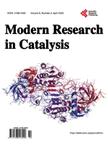Temperature and pH Dependent Deactivation of Cutinases from <i>Thermobifida fusca</i>: A Comparative Study of Homologous Enzymes
Temperature and pH Dependent Deactivation of Cutinases from <i>Thermobifida fusca</i>: A Comparative Study of Homologous Enzymes作者机构:Biochemical Engineering Laboratory Department of Biotechnology Indian Institute of Technology Guwahati Guwahati India
出 版 物:《Modern Research in Catalysis》 (催化剂现代研究(英文))
年 卷 期:2014年第3卷第4期
页 面:128-135页
主 题:Cutinase Thermal Deactivation Thermostability Thermodynamics
摘 要:Thermostability of two homologous cutinases, Cut1 and Cut2 from Thermobifida fusca NRRL B-8184 was inves-tigated at combination of different pH and temperature in the range of pH 6 - 9 and temperature 45℃ - 80℃, re-spectively. The deactivation rate constants, the half-life and thermodynamic parameters, viz., △H*, △S*, △G* and activation energy kinetics of inactivation of the cutinases were assessed at different combinations of pH and temperature and compared. The optimal pH and temperature for the least degree of deactivation for Cut1 and Cut2 were found to be 8℃ and 45℃, respectively. The deactivation process was found to be faster at pH 6 and 9, with minimum deactivation at pH 8 for both the cutinases. It was found that △S* values are negative for both the enzymes and △H* value of Cut2 was 1.5 fold higher than that of Cut1 in the range of pH studied. Cut2 was found to be thermodynamically more stable with 1.7 fold higher deactivation energy at pH 6 and 7 and 1.4 fold higher deactivation energy at pH 8 and 9 in comparison to Cut1.



